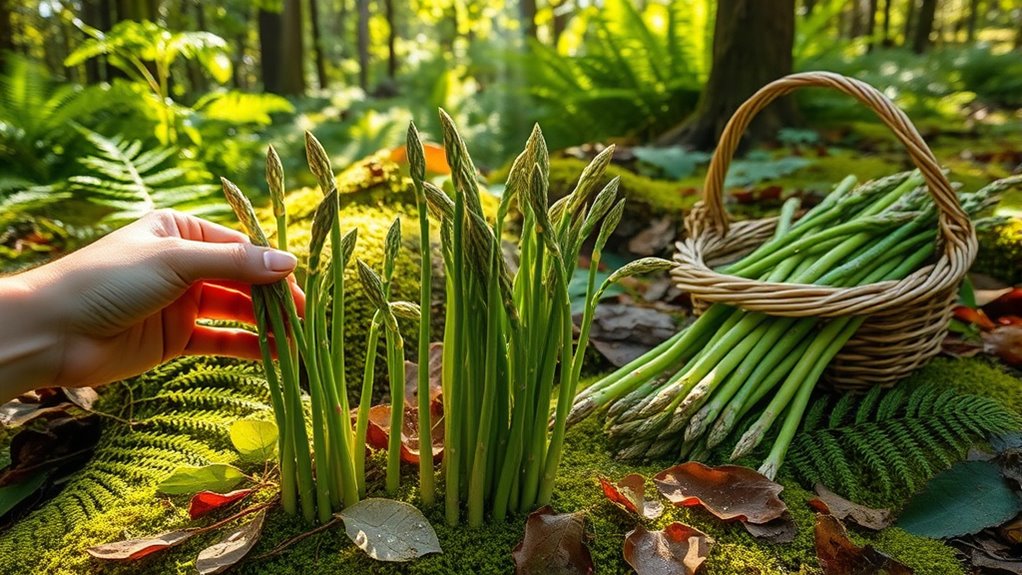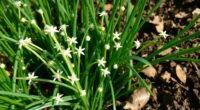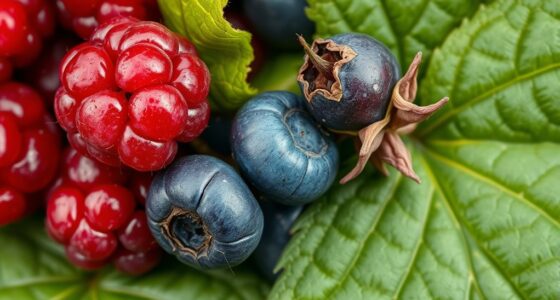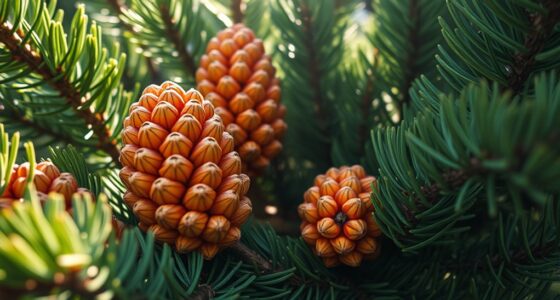To forage for wild asparagus, seek moist, well-drained areas like marsh edges, ditches, or saline soils, and look for early spring spears emerging from the ground. Harvest when the spears are about 6 inches tall and tender, snipping just above ground. Handle them gently, rinse lightly, and consider preservation methods like freezing or pickling. If you keep exploring, you’ll discover tasty recipes and tips to make the most of this seasonal treat.
Key Takeaways
- Identify suitable foraging sites like moist, well-drained soils near saltwater or irrigated areas with full sun.
- Harvest spears early in spring, cutting just above ground, when they are about 6 inches tall with tight tops.
- Handle spears gently, rinse lightly, and store in cool, dark places; preserve by blanching, freezing, or pickling for extended use.
- Incorporate wild asparagus into meals by sautéing, grilling, or adding raw to salads for fresh, nutrient-rich flavors.
- Grow asparagus in well-drained sandy loam, companion plant with tomatoes, parsley, dill, strawberries, and chives for healthy harvests.
Identifying Ideal Foraging Locations for Wild Asparagus
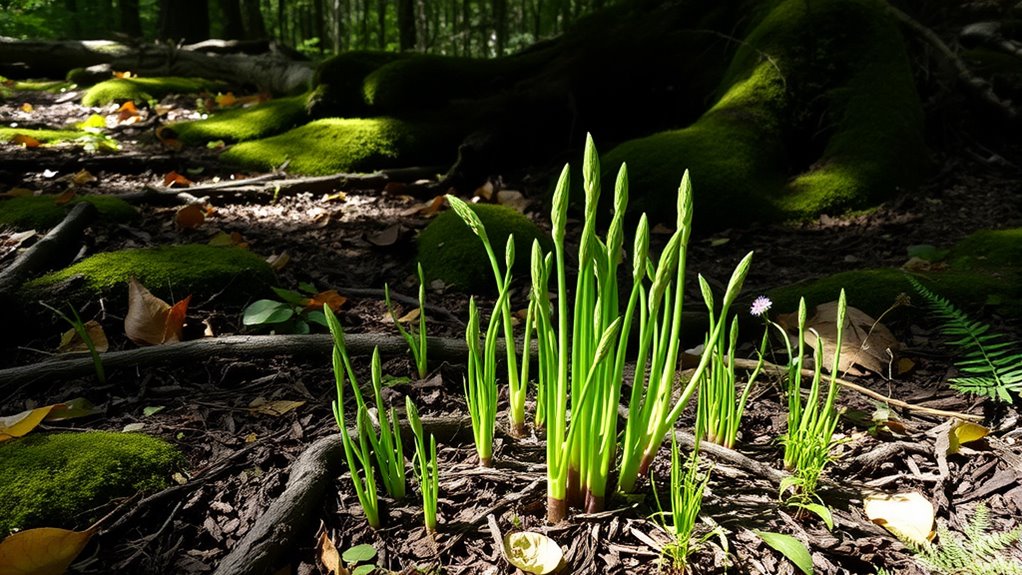
To find ideal foraging spots for wild asparagus, start by looking near moist, well-drained soils that aren’t waterlogged. Focus on areas like marsh edges, drainage ditches, and riparian zones where the soil remains consistently moist but not saturated. Natural habitats such as these provide optimal conditions for wild asparagus growth. Wild asparagus thrives in alkaline or saline soils, so pay attention to regions with these conditions, often near saltwater zones or saline soils. Check along farm fences bordering irrigated pastures or in arid regions with irrigation ditches, as these spots tend to host abundant growth. Remember, wild asparagus prefers full sun and open areas, so avoid dense forests or shaded woods. Look for signs of nearby vegetation like hemlock or curly dock, which often grow in the same habitats. Additionally, assessing soil quality can help identify the best locations for successful foraging, especially when combined with soil quality assessments to identify optimal growing environments. Being mindful of vibrational energy in your surroundings can also enhance your foraging experience by aligning you with nature’s abundance.
Recognizing Signs of Growing Wild Asparagus
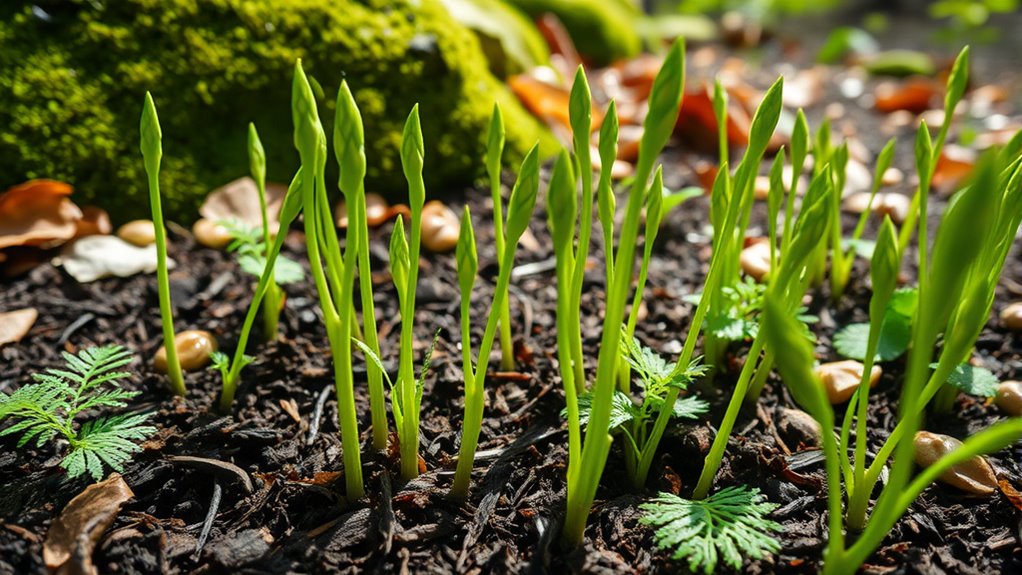
Once you’ve identified promising foraging locations for wild asparagus, the next step is recognizing the signs of its growth stage. In spring, look for thin, hidden spears emerging from the ground, indicating young plants that need more time to mature. During summer, mature plants develop bushy, fern-like stalks with a triangular branching pattern, often in dense clusters. In late summer, older plants may show bright red, white, or brown berries, making them easier to spot. Come fall, the foliage turns bright yellow, providing a distinctive sign of mature plants. In winter, the dried, brown stems remain upright or bent, revealing the plant’s location even when it’s dormant. Understanding the growth cycle of wild asparagus helps ensure proper harvesting timing and plant health. Recognizing these signs helps guarantee you’re harvesting at the right time and plant age.
Best Time of Year to Harvest Wild Asparagus

Wild asparagus typically emerges in late April to early May, though the exact timing depends on local climate conditions. Warmer springs cause it to appear earlier, while cooler springs delay growth.
Wild asparagus emerges in late April to early May, depending on local climate conditions.
The harvesting window usually lasts six to eight weeks, so timing is key. In regions like Colorado or parts of the Mediterranean, you might see it during springtime, but always observe local cues. plant growth cycles are closely tied to environmental factors and influence when the best harvest occurs. Be mindful to stop harvesting by July 1 to allow the roots to recover and strengthen for next year. Temperature, moisture, and sunlight critically influence growth, so ideal conditions lead to a more abundant harvest. Understanding soil conditions can help determine the optimal time for harvesting, as healthy soil promotes vigorous growth. Monitoring weather patterns can also provide valuable clues to optimal harvesting periods. Recognizing regional climate variations helps you better predict wild asparagus emergence based on your specific location, ensuring you harvest at peak tenderness. Additionally, paying attention to soil moisture levels can improve your success in identifying the best harvest time.
Techniques for Harvesting and Handling Asparagus Spears
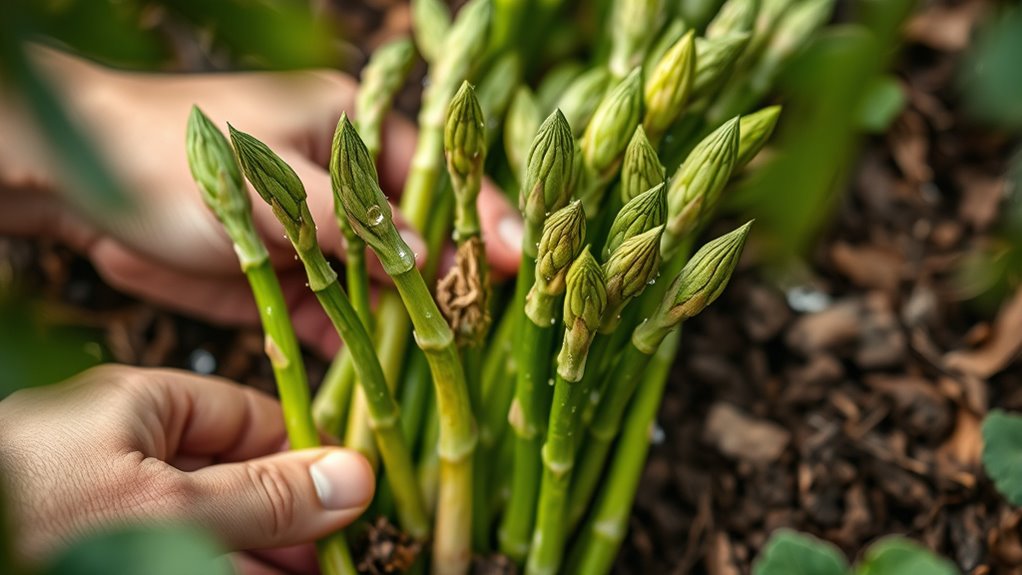
When harvesting wild asparagus, it’s important to carefully inspect areas near old brush and grassy patches, as these are common growth spots in early spring. Use a knife or clippers to cut the spear just above ground level instead of snapping it off, which helps the plant recover. Choose spears with tight tops and firm textures, avoiding older ones with loosened tips. Harvest when spears reach about 6 inches, roughly a day’s growth. Don’t take too many from one plant; leave some to mature for future harvests. Handle the spears gently, placing them immediately in a foraging basket or backpack to prevent bruising. Rinse lightly in cool water before storage, and keep them cool and out of direct sunlight to maintain freshness. Being mindful of contrast ratio can also help you assess the visual quality of your home cinema setup. Additionally, being aware of symptoms of breast cancer can promote early detection and timely medical attention. Understanding the growth cycle of wild asparagus can further enhance your foraging success.
Preparing and Preserving Your Wild Asparagus

After harvesting your asparagus spears, proper preparation guarantees they taste their best and last longer. Begin by rinsing them in a large bowl of cold water, gently swishing to remove dirt and debris. Celebrity transformations and lifestyle trends can influence how you choose to prepare or serve your asparagus for special occasions. Trim off the woody ends by snapping or cutting them. If some wild asparagus tastes bitter, blanch it in boiling salted water for about 2 minutes, then drain and dry thoroughly with a towel. Store the cleaned and trimmed spears in a cool, moist place to maintain freshness. To preserve, blanch the asparagus for 2-3 minutes before freezing, or slice and soak in brine for pickling. Dehydrate using a dehydrator, or can for year-round use. Proper preparation ensures your wild asparagus stays flavorful and ready for your favorite recipes.
Nutritious Benefits of Wild Asparagus in Your Diet
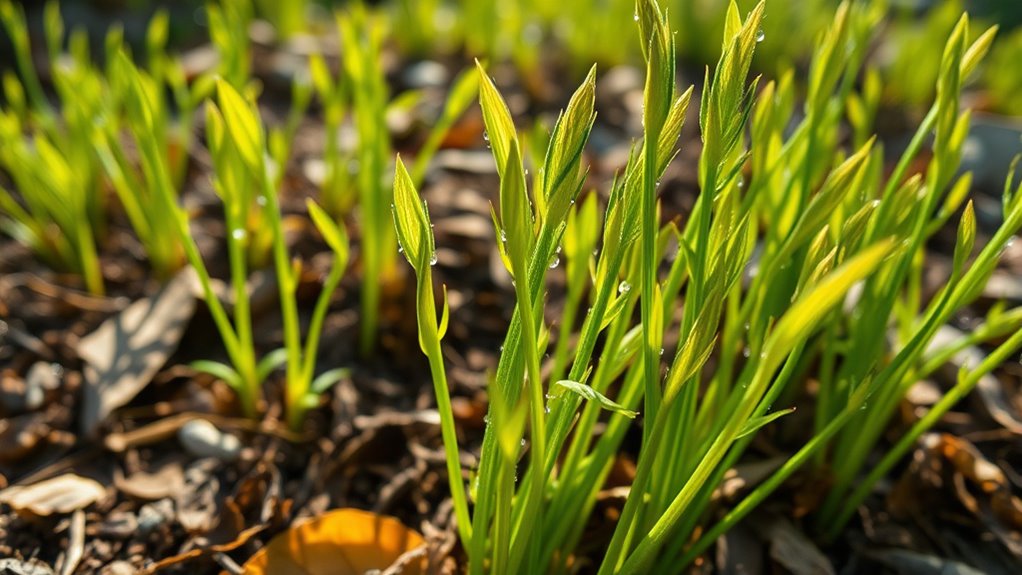
Incorporating wild asparagus into your diet offers a wealth of nutritional benefits that can support overall health. It’s rich in vitamins A, B1, B2, C, and E, which boost your immune system, vision, and skin health.
The mineral content, including magnesium, phosphorus, calcium, and iron, promotes strong bones, energy production, and blood health. Folate from asparagus helps reduce risks of heart disease, dementia, and neural tube defects.
With about 2.2 grams of protein per serving and only around 3 calories per stalk, it’s an excellent low-calorie, high-fiber addition for weight management and digestive health. Proper storage of wild asparagus can help retain its freshness and nutritional value for longer periods. Additionally, understanding nutritional analysis can assist you in making informed choices about incorporating wild asparagus into your meals.
Its antioxidant properties, driven by vitamins E and C, flavonoids, polyphenols, and glutathione, help combat oxidative stress, supporting your immune function and protecting cells from damage. Cost and budgeting considerations can influence how you incorporate wild asparagus into your meals, whether foraged or purchased. Proper handling and home decor techniques can also enhance the presentation when serving this nutritious delicacy. Incorporating techniques such as proper storage can further preserve its nutritional integrity and flavor.
Companion Plants and Natural Environment Insights

Companion planting with wild asparagus can boost your garden’s health and productivity by fostering beneficial interactions among plants. Tomatoes improve soil quality by enhancing nutrient availability and absorb excess nitrogen, which benefits asparagus. Space them about 18 inches apart to prevent shading, and support their growth with stakes.
Parsley adds nitrogen, enhancing asparagus flavor and foliage health, and should be planted at least six inches away. Dill attracts helpful insects and boosts biodiversity, creating a balanced environment. Strawberries share nutrients, create a microclimate, and act as natural pest deterrents.
Chives repel aphids and spider mites with their strong scent, protecting your asparagus while offering culinary benefits. In the natural environment, asparagus prefers well-drained sandy loam, full sun, consistent moisture, and crop rotation to prevent pests and diseases.
Creative Ways to Cook and Enjoy Wild Asparagus
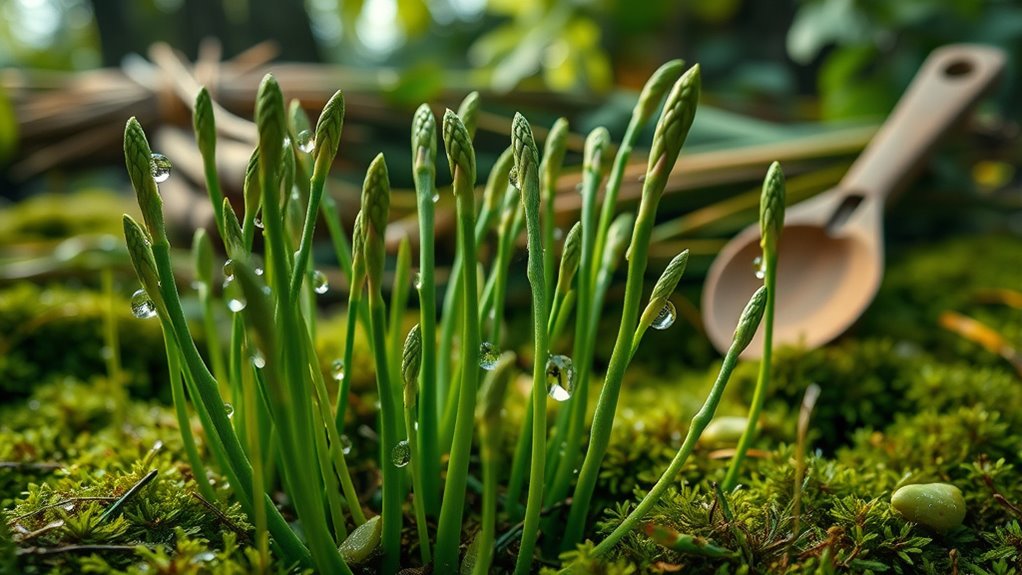
Wild asparagus offers a versatile array of cooking options that highlight its earthy flavor and tender texture. You can sauté it with eggs and serrano ham for a traditional tortilla or fold it into a hearty frittata with cheeses like Parmesan or goat cheese.
For a fresh twist, toss raw shaved asparagus with lemon juice, vinegar, nuts, and microgreens to create a vibrant salad. Incorporating raw vegetables into your meals can preserve nutrients and enzymes that might be lost during cooking. Using seasonal ingredients can also enhance the freshness and flavor of your dishes.
Grilling wild asparagus with olive oil and seasonings adds a smoky flavor, perfect as a side. Incorporating fiber-rich ingredients like wild asparagus can enhance digestive health and promote satiety in your meals.
Adding nutrient-dense foods such as wild asparagus can boost the overall health benefits of your dishes.
Frequently Asked Questions
How Can I Differentiate Wild Asparagus From Toxic Look-Alikes?
To tell wild asparagus apart from toxic look-alikes, you look for triangular leaf scales on the lower spears, which resemble those of cultivated asparagus.
Check for feather-like modified stems instead of leaves, and note white or yellowish green bell-shaped flowers.
Be cautious of plants with fern-like foliage, small white or yellow flowers, or red berries, which indicate toxic species like hemlock or lily of the valley.
Always verify before harvesting.
Are There Any Legal Restrictions on Foraging Wild Asparagus in Certain Areas?
You wonder if the law fences in your foraging adventure. In many areas, rules act like silent guardians, restricting harvests on public lands or private property without permission.
Regions like the Bay Area often ban foraging in parks, while some countries are more lenient. Always check local regulations—they’re the map guiding respectful foraging.
Ignoring these laws can lead to fines or penalties, so stay informed and tread carefully.
What Safety Precautions Should I Take When Harvesting Wild Asparagus?
When harvesting wild asparagus, you should wear gloves to protect your hands from thorns and briars.
Use sturdy boots and pants for safety, and carry a knife or hand-saw to cut the spears carefully.
Always check the area for pollutants, avoid chemical-treated zones, and wash the asparagus thoroughly before eating.
Respect private property, and be mindful not to over-harvest or damage the environment.
Can Wild Asparagus Be Cultivated at Home for Continuous Harvests?
You can definitely cultivate wild asparagus at home for continuous harvests. Choose a sunny, well-drained spot with rich soil, and prepare it with compost and fertilizer.
Transplant dormant plants carefully, ensuring they’re spaced 9 to 12 inches apart.
Keep the area weed-free, water consistently, and fertilize regularly.
With patience and proper care, your wild asparagus will thrive, providing fresh spears season after season.
How Do I Identify the Age and Health of Wild Asparagus Plants?
To identify the age and health of wild asparagus, look at the plant’s physical traits. Mature plants have tall, branching stems with feathery leaves and may bear red berries, indicating maturity.
Healthy plants grow quickly, have vibrant green leaves, and resist pests.
Check the environment—plants in sunny, well-drained soils thrive.
Avoid yellowing or browning leaves, as these signs point to stress or disease, affecting the plant’s overall health.
Conclusion
Like a modern explorer uncovering hidden treasures, you’ve learned to seek out wild asparagus with care and confidence. By respecting nature’s signals and harvesting responsibly, you connect with a tradition as old as the earth itself. As you savor its fresh flavors, remember that each spear is a reminder of nature’s generosity—an echo of the timeless dance between human curiosity and the wild’s secrets. Embrace this bounty, and let it nourish both body and soul.

